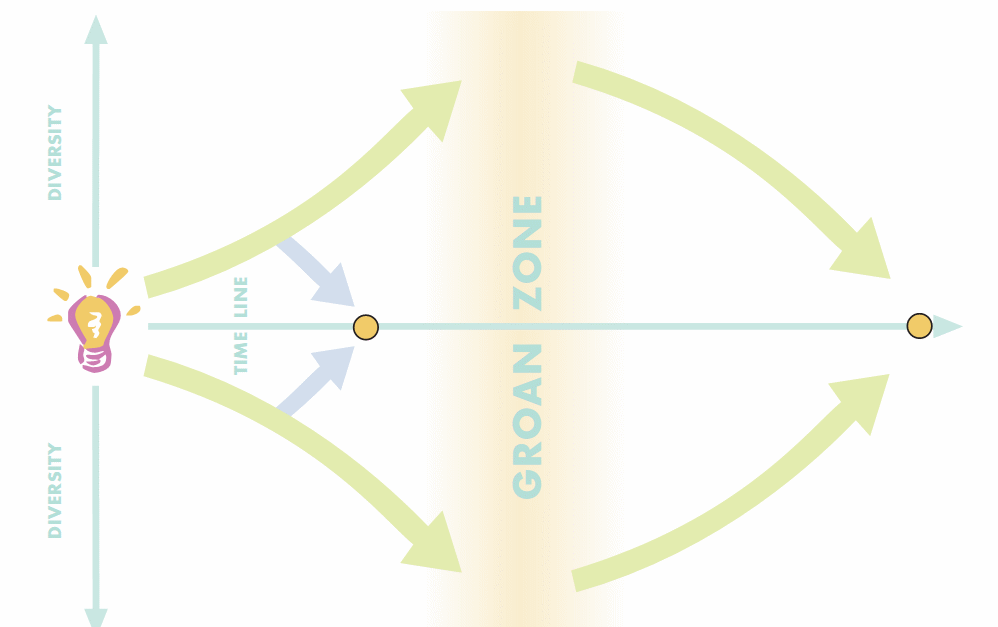Divergent and convergent thinking

Diamond graphic by Darrell Freeman at Colour
The diamond is a map that points to three phases that groups pass through as they move from questions to insights. Groups begin with divergent thinking, sit for a while in the chaos and uncertainty of “The Groan Zone” and later move into convergent thinking.
Today I found a nice description of these modes of thinking, buried in an article on neuroscience and fundamentalism
Convergent reasoning involves an assembly of known information and results in a solution within the realm of what is already known. Most problem solving occurs this way. It is instilled, for example, in medical school students. If a physician sees a person in the emergency room that has a fever and is comatose, they are taught that there are two possible disorders that might give these signs: an infection or a heat stroke. If this patient is found to have a stiff neck, the physician considers the possibility that the patient’s fever and unconsciousness are related to an infection of the central nervous system, such as meningitis. To obtain further converging evidence the resident doctor may perform a spinal tap; if the analyzed spinal fluid reveals certain indicators there is now sufficient converging evidence to make a diagnosis of meningitis and to start antibiotic therapy.Divergent reasoning, on the other hand, enables a person to arrive at a previously unknown solution (at least unknown to the person who is doing the reasoning). When a person is confronted with a problem and decides that the existing information is insufficient to develop a satisfactory solution, he or she may diverge from the information and imagine,or reason about, new possibilities. William James, who first put forth the concept of divergent reasoning, stated:
Instead of thoughts of concrete things patiently following one another in a beaten track of habitual suggestion, we have the most abrupt cross-cuts and transitions from one idea to another … unheard of combinations of elements, the subtlest associations of analogy … we seem suddenly introduced into a seething cauldron of ideas … where partnerships can be joined or loosened … treadmill routine is unknown and the unexpected is the only law.
The human capability for divergent reasoning results in a nearly limitless range of creative outcomes, from entirely personal to world changing. Surely humanity’s earliest innovations were life altering, as were the many that followed. Recall our eventual acceptance (against initially unyielding church doctrine) of Copernicus’s unfathomable idea that the Sun, and not the Earth, was at the center of our solar system, or Einstein’s affront to the known laws of physics with his concept that matter and energy are different forms of the same thing. But even more mundane activities, like resolving an unacceptable marital situation by seeking conduct on the part of one of the partners that was previously not considered, discovering a treatment solution for a heretofore incurable disease,creating a work of distinctive art, finding an alternative to war in a tense geopolitical situation, a chef’s creation of a new recipe, carefully arranging flowers in vase, or making up a bedtime story, are examples of creative acts resulting from the ability to diverge from current circumstances and consider or enact new possibilities. Certainly, both convergent and divergent reasoning serve to enhance our well being. But it is an individual’s ability to diverge from what is familiar and move beyond the known into a new understanding which is the essence of creativity, and that which gives rise to advancement. In the words of Frank Zappa, “Without deviation from the norm, ‘progress’ is not possible.” Whether a person chooses to question and think on his or her own or remains unconditionally adherent to religious dogma, might relate to how specific areas of the brain are utilized–or not.
Interesting, eh?
[tags]Sam Kaner, Myriam Laberge[/tags]


[…] Divergent and convergent thinking […]
[…] Chris Corrigan has a post about the groan zone, the place in between seeing the problem (divergence) and coming together with how we will address it (convergence). It is here that chaos looks like bedlam or pandemonium, with no rhythm nor reason. […]
[…] While the circles do look nested one within the other there is another shape tat they create together that is important. Travelling clockwise from the bottom of the diagram you will notice that the space between the circles grows and then shrinks away again. This is intentional. I have named these three phases after Sam Kaner’s three zones in the Diamond of Participation: Divergent phase, Groan Zone and Convergent Phase. This is the shape of an overall project, and it is a pattern that scales. The Five Breaths (red) […]
[…] Sam Kaner et. al.’s Diamond of Participation for groups that are moving from a question to emergent insight or learning. […]
[…] readers will know that I use the diamond of participation often as a map to organize and design meeting processes. One feature of the diamond is the three […]
[…] for gaining clarity on work include design tools like the diamond of participation, the chaordic stepping stones and other project planning tools that invite clairty about questions […]
[…] toutefois découvert, dans des processus tels que les Cinq respirations, le Diamant de la participation ou encore le Processus en U, des alliés essentiels pour me permettre d’accompagner des […]
[…] trick to using a Typology is to use it for divergent rather than convergent thinking. Unless your confident that the (proto)types are “clearly defined, mutually exclusive and […]
[…] thinking “AAARGH” as I wasn’t sure how to bring it all together. I thought about divergent and convergent processes (and remembered to breathe) and didn’t go to pieces. We moved from the circle where we had […]